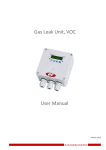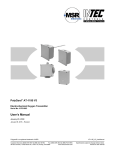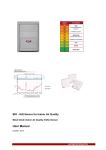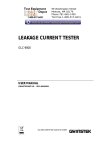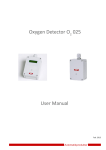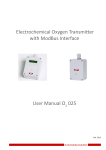Download User Manual - Automatikprodukter
Transcript
Indoor Air Quality Industrial Detector VOC/CO2 BIO 124 User Manual May, 2011 User Manual – Industrial Detector for Air Quality BIO 124 Page 2 1 Intended Use ....................................................................................................................................... 3 2 Functional Description ...................................................................................................................... 3 2.1 2.2 2.3 3 Installation .......................................................................................................................................... 5 3.1 3.2 4 Addressing, only for DGC-05_Bus mode ................................................................................... 7 Option Relay Output ................................................................................................................... 7 Inspection and Service ...................................................................................................................... 8 6.1 6.2 7 Wiring Connection ...................................................................................................................... 6 Commissioning .................................................................................................................................. 6 5.1 5.2 6 Mounting Instructions ................................................................................................................. 5 Installation .................................................................................................................................. 5 Electrical Connection ........................................................................................................................ 6 4.1 5 Control Mode .............................................................................................................................. 3 VOC Sensor ............................................................................................................................... 3 VOC Measurements ................................................................................................................... 4 Inspections ................................................................................................................................. 8 Exchange of Sensor Element ..................................................................................................... 8 Troubleshooting ................................................................................................................................. 8 7.1 7.2 Analog Mode .............................................................................................................................. 8 DGC-05_Bus Mode .................................................................................................................... 8 8 MODBus Specification ....................................................................................................................... 9 9 Technical Data .................................................................................................................................. 11 10 Figures ............................................................................................................................................ 13 11 Notes and General Information .................................................................................................... 15 11.1 11.2 11.3 11.4 Intended Product Application ................................................................................................ 15 Installers’ Responsibilities .................................................................................................... 15 Maintenance ......................................................................................................................... 15 Limited Warranty ................................................................................................................... 15 User Manual – Industrial Detector for Air Quality BIO 124 Page 3 Detector Air Quality (VOC/ CO2) with Metal Oxide Semi-conductor Sensor 1 Intended Use The BIO124 detector with digital processing of the measuring values and temperature compensation is used for measuring the air quality and the temperature in indoor areas within the environmental conditions as specified in the Technical Data. The intended sites are all areas being directly connected to the public low voltage supply, e.g. residential, commercial and industrial ranges as well as small enterprises (according to EN50 082). The BIO 124 detector must not be used in potentially explosive atmospheres. 2 Functional Description 2.1 Control Mode In addition to the analog output the detector is equipped with a serial interface RS-485 for the connection to the GCD-05 system. Analog mode: The analog output can be selected as current signal with (0)4-20 mA or as voltage signal (0)2-10 V. GCD-05_Bus mode: The detector can be connected to the GCD-05 system via the RS-485 interface. In this mode there is an analog input for the connection of an additional 4-20 mA transmitter. The two measuring values are transmitted via the RS-485 interface to the gas controller. The cable topology for the RS-485 bus can be taken from the “Guidelines for wiring and commissioning of the GCD-05 hardware”. MODBus mode: The detector can be connected via RS-485 interface / MODBus protocol to different devices like, DDC, SPC, BMS, PC etc. as a central unit. In this mode there is an analog input for the connection of an additional 4-20 mA detector. The two measuring values are transmitted via the RS-485 interface / MODBus protocol. The cable topology for the RS-485 bus can be taken from the “Guidelines for wiring and commissioning of the GCD-05 hardware”. The analog mode is available in parallel to the GCD-05 bus mode or the MODBus mode. 2.2 VOC Sensor The semi-conducting metal oxide sensor measures the electrical conductivity of the nanocrystalline metal oxide coated on a heatable substrate. The typical operating temperature is between 300 and 400 °C. The doping of the metal oxide with noble metals results in a positive sensibility to combustible gases like VOCs, carbon monoxide and natural gas. The doping permits the adaptation to the demands of the measuring task. VOCs are partially or totally burnt at the sensor surface by the oxygen of the metal oxide. The electrons released in the semi-conductor by this process lead to an increase of the electrical conductivity. At the end of the combustion process, the metal oxide returns to its initial state by incorporating oxygen from the air, with the conductivity also adopting the initial value. The change of the conductivity is evaluated via the internal micro-controller and output as a standard signal. User Manual – Industrial Detector for Air Quality BIO 124 2.3 Page 4 VOC Measurements The VOC content in indoor areas is mainly determined by the persons present and their activities. See table 1. When for example working with cleaning agents or when cooking, VOCs (Volatile Organic Compounds) are set free, but also human respiration is a constant source of volatile metabolism products (VOCs). The air quality sensor detects the increasing VOC level and calculates the proportional CO2 value. The VOC/CO2 correlation was determined by taking measurements under real conditions. See diagram 1. To this day, there aren’t any standard signals for the VOCs; therefore the IAQ air quality sensor reduces the measured VOC values to CO2 equivalents with the unit ppm. This grants the compatibility to existing CO2 ventilation standards. Each time the IAQ air quality detector is switched on, it runs through a warm-up period of 20 minutes. During this warm-up period there aren’t any measurements; the sensor outputs the signal of 80% of the measuring range. After the warm-up period, the sensor interprets the currently read VOC value as zero-point, independently from the actual concentration. An internal algorithm continuously updates the zero-point by taking the lowest measured VOC value. Therefore the ambient air should be of low VOC content after the warm-up period. This can be obtained by shortly venting when starting the measurements with the 80% signal. If the sensor isn’t started at low VOC concentrations, it can take a couple of days until the internal algorithm has updated the zero-point so far that effective measuring results are available. The natural sensor drift and ageing is corrected by the implemented control algorithms. Indoor Air Contamination Source Emission Source Typical Substances VOCs Ventilation Others Acetone, Ethanol, Isoprene CO2 Humidity Nonanal, Decanal, α-Pinene *Skin respiration & transpiration Humidity *Flatus Methane, Hydrogen Human Being *Cosmetics Limonene, Eucalyptol *Household Supplies Alcohols, Esters, Limonene Unburnt Hydrocarbons *Combustion CO (Engines, Appliances, Tobacco CO2 Smoke) Humidity *Paints Formaldehyde, Alkanes, *Adhesives Alcohols, Aldehydes, *Building Material *Solvents Ketones, Siloxanes *Furniture *Carpets *Office Equipment Toluene, Xylene, Decane +Consumer Products *PVC *Printers/Copiers, Benzene, Styrene, Phenole Computers *Breath Table 1 – Typical indoor air contaminants (VOC and others) demand controlled permanent (5-10%) User Manual – Industrial Detector for Air Quality BIO 124 VOCs CO2 Page 5 Window opened/closed Odors VOC 0 CO2 1h 2h 3h 4h Diagram 1: Correlation CO2- VOC (records from a business meeting session) 3 Installation Note: Avoid any force (e.g. by thumb) on the sensor element during operation or installation. Electronics can be destroyed by static electricity. Therefore, do not touch the equipment without a wrist strap connected to ground or without standing on a conductive floor (acc. to DIN EN100015). 3.1 Mounting Instructions When choosing the mounting site please pay attention to the following: Do not mount the transmitter next to doors, windows, air inlets and outlets. Free air supply must be granted. Vertical mounting (air inlet at the transmitter down/up) Avoid direct sunlight. No heat sources around in case of temperature measurement. Duct mounting Mount only in a straight section of duct with minimum air vortex. Keep a minimum distance of 1 m (3.5 feet) from any curve or obstacle. Mount only in a duct system with a maximum air velocity of 10 m/s (2000 ft/min) or less. Mounting must be performed so that the probe openings are in line with the airflow. 3.2 Installation Open the cover. Unplug basic PCB carefully from the bottom part. Fix bottom part by screws vertically to the wall (terminal blocks to the ground). Plug in the basic PCB at X4 and X5 with care. Replace the cover. User Manual – Industrial Detector for Air Quality BIO 124 Page 6 4 Electrical Connection Consider static electricity! See 3. Mounting Installation of the electrical wiring should only be executed by a trained specialist according to the connection diagram, without any power applied to conductors and according to the corresponding regulations! Avoid any influence of external interference by using shielded cables for the signal line, but do not connect the shield. Recommended cable for analog mode: J-Y(St)Y 2x2x0.8 LG (20 AWG), max. resistance 73 /km (20.8 /1000 ft). It is important to ensure that the wire shields or any bare wires do not short the mounted PCB. RS485 bus mode: Required cable: J-Y(St)Y 2x2x0.8 LG (20 AWG), max. res. 73 /km (20.8 /1000 ft) When selecting and installing the cables you have to comply with the regulations concerning the RS 485 bus installation. The installations have to be executed in line topology. Cable length and type have to be considered as well. 4.1 Wiring Connection Open the cover. Unplug basic PCB carefully from terminal blocks X4 and X5. Insert the cable and connect cable leads to terminal blocks. See fig. 1 and 2. Replug the PCB in the terminal blocks X4, X5 with care. Replace the cover. 5 Commissioning Consider commissioning instructions at any exchange of the sensor element as well. Only trained technicians should perform the following: Check mounting location. Select output signal form: Current or voltage, and starting point 0 or 20%. See fig.5. Check power voltage. Check PCB SM03-002 for correct mounting at X4 and X5. Addressing of the transmitter in the GCD-05_Bus mode. Required instruments for commissioning (calibration) of the transmitter: Calibration tool GCD-05 STL (only for calibration with service tool GCD-05). GCD-05 configuration and calibration software incl. USB/RS-485 communication set (only for software calibration mode). User Manual – Industrial Detector for Air Quality BIO 124 Page 7 5.1 Addressing, only for GCD-05_Bus mode In the GCD-05_Bus mode each detector gets its communication address. In the standard version with the communication connector X12, addressing is done by means of the GCD-05 Service Tool or by the GCD-05 Configuration and Calibration Software. See user manual of the Service Tool or of the Configuration and Calibration Software. In the manual addressing version which can be identified by the address switch being equipped, there is a maximum of 60 addresses to be selected. See fig. 3. The jumper is responsible to define the address group and the switch to define the address according to the following table. Switch position 0 1 2 3 4 5 6 7 8 9 A B C D E F Jumper pos. 01 = address inactive 01 02 03 04 05 06 07 08 09 10 11 12 13 14 15 Jumper pos. 02 = address inactive 16 17 18 19 20 21 22 23 24 25 26 27 28 29 30 Jumper pos. 03 = address inactive 31 32 33 34 35 36 37 38 39 40 41 42 43 44 45 Jumper pos. 04 = address inactive 46 47 48 49 50 51 52 53 54 55 56 57 58 59 60 5.2 Option Relay Output The two relays are activated in dependence of the gas concentration. If the gas concentration exceeds the adjusted alarm threshold, the corresponding relay switches on. If the gas concentration falls below the threshold minus hysteresis, the relay switches off again. The contact function for relay 2, NC (normally closed) or NO (normally open), can be selected via the jumper NO/NC. See fig 1 and 3. Relay 1 is equipped with a change-over contact. Via the ModBus interface the two alarm thresholds and the hysteresis are freely adjustable at the PC within the measuring range. The procedure can be read from the user manual “ModBus Software”. The following parameters are factory-set. Alarm threshold 1 = Relay 1: Alarm threshold 2 = Relay 2: Switching hysteresis: 800 ppm 1200 ppm 200 ppm User Manual – Industrial Detector for Air Quality BIO 124 Page 8 6 Inspection and Service 6.1 Inspections Inspection and service of the transmitters should be done by trained technicians and executed at regular intervals. We therefore recommend concluding a service contract with AP or one of their authorized partners. 6.2 Exchange of Sensor Element Please send the complete PCB back to the manufacturer for exchange of the sensor. 7 Troubleshooting 7.1 Analog Mode Trouble Cause Solution Output signal < 3 mA / 1.5 V and/or control voltage < 30 mV only for starting signal 2V/4 mA Jumper 0-20 % not set Check jumper position Measure tension at X4: Two-wire: Pin 1 (+) and 4 (-) Three-wire: Pin 1 (+) and 2 (-) Output signal > 22 mA /220 mV No reaction of the output signal in spite of VOC concentration 7.2 Power voltage not applied PCB not plugged in correctly at X4/ X5 Wire break Short-circuit Replug PCB correctly Check the wiring Check the wiring Power voltage not applied Signal (pin 4) not wired correctly Measure tension at X4 Check the wiring DGC-05_Bus Mode Trouble Cause Solution Yellow LED not shining Power voltage not applied Measure tension at X4: Pin 1 (+) and 2 (-) Yellow LED not flashing PCB not plugged in correctly at X4/X5 Wire break No communication at the transmitter Replug PCB correctly Check wiring Transmitter not addressed, check bus wiring incl. topology and termination Voltage < 16 V No control voltage at calibration Jumper V-A not set Set the jumper. Remove it after calibration! User Manual – Industrial Detector for Air Quality BIO 124 Page 9 8 MODBus Specification Interface settings Baud: Start bit Stop bit Parity 9600 1 1 No Read Register description Addr. Function Notes 0 1 Sensor type Versions number Internal sensor measurement value External sensor measurement value Internal sensor measurement value External sensor measurement value Temperature ADC value res res res E.g… 1160 for ADTC3-1160 Air-quality (VOC)-transmitter E.g. xXxx = Addressing and calibration via tool Value is normalized on the numerical range of 0 to 10.000 Value -10 means sensor error Value is normalized on the numerical range of 0 to 10.000 Value -10 means sensor error Value is normalized starting from 0 up to the gas measuring range (e.g. VOC 450- 4000 ppm). Value -10 means sensor error Value is normalized starting from 0 up to the gas measuring range (e.g. CO 300ppm). Value -10 means sensor error Internal temperature value in digits For future applications For future applications For future applications Own bus address, e.g. 15 Value range from 1 to 255 The address 245 is defined ex works. When the Selector cable is plugged-in, the sensor reports to address 246, but displays its own stored address. (246 isn't stored and isn't valid any more after plugout. It is only used to find already addressed devices.) EEPROM value must not be changed continuously. E.g. 10.000 non calibrated ex works, value range 3000 to 30.000 E.g. 0 non calibrated ex works, value range 0 to 1.000 The value of this register is subtracted from the measured value. For future applications E.g. 300 for CO sensor. This value is used for the conversion of the registers 4 and 5 in order to calculate the full-scale value. Setpoint level for Relay 1 Setpoint level for Relay 1 2 3 4 5 6 7 8 9 10 Transmitter Bus address 11 Gain factor 12 Zero offset value 13 res 14 Full-scale value 15 16 Relay 1 –Setpoint value Relay 2 –Setpoint value Output 3 –Setpoint value Output 4 –Setpoint value Hysteresis res res res 17 18 19 20 21 22 Setpoint level for Output 3 (open Collector X9 pin 1) Setpoint level for Output 4 (open Collector X9 pin 3) Hysteresis Value from 0 to Full-scale value For future applications For future applications For future applications User Manual – Industrial Detector for Air Quality BIO 124 Page 10 Write Register description Addr. Function 0 Transmitter B s address 1 Gain factor 2 Zero offset value 3 res 4 Full-scale value 5 Relais 1 –Setpoint value 6 Relais 2 –Setpoint value 7 8 Output 3 –Setpoint value Output 4 –Setpoint value 9 Hysteresis 10 11 12 res res res Notes Own bus address, e.g. 15 Value range from 1 to 255 The address 245 is defined ex works. When the selector cable is plugged-in, the sensor reports to address 246, but displays its own stored address. (246 isn't stored and isn't valid any more after plugout. It is only used to find already addressed devices.) EEPROM value must not be changed cyclically. E.g. 10000 non calibrated ex works, value range 3000 to 30.000. EEPROM value must not be changed cyclically. E.g. 0 non calibrated ex works, value range 0 to 1.000 The value of this register is subtracted from the measured value. EEPROM value must not be changed cyclically. For future applications E.g. 100 for Ex sensor. This value is used for the translation of the registers 4 and 5 in order to calculate the full-scale value. EEPROM value must not be changed cyclically. Setpoint level for Relay 1 EEPROM value must not be changed cyclically. Setpoint level for Relay2 EEPROM value must not be changed cyclically. Setpoint level for Output 3 (open Collector X9 pin 1) EEPROM value must not be changed cyclically. Setpoint level for Output 4 (open Collector X9 pin 3) EEPROM value must not be changed cyclically. Hysteresis Value from 0 to Full-scale value EEPROM value must not be changed cyclically. For future applications For future applications For future applications User Manual – Industrial Detector for Air Quality BIO 124 Page 11 9 Technical Data Electrical Power supply Power consumption (without options) Sensor data1 Gas type Sensor element Measuring range Measuring range Accuracy Repeatability Response time Warm-up time Sensor life expectancy 18 - 28 VDC/AC, reverse polarity protected < 1 Watt (average) * VOC (alcohols, aldehydes, aliphatic hydrocarbons, amines, aromatic hydrocarbons, carbon monoxides, methane, LPG, ketones and organic acids) Metal oxide semi-conductor 450 – 4000 ppm VOC 450 – 4000 ppm VOC ± 150 ppm ± 5 % of reading t90 < 60 s 20 min. > 10 years/ normal ambient conditions Output signal OUT1 linear D/A resolution Electrical parameters 4-20 mA / 0 -10 VDC / 450 - 4000 ppm VOC 10 Bit, 10 mV ROUT < 100 Ohm, RLOAD > 5 kOhm Environmental Conditions Humidity Working temperature Storage temperature 5 to 95% RH non-condensing 0 °C to + 50 °C (32 °F to 122 °F) -10 °C to + 50 °C (14 °F to 122 °F) General Information Operating environment Physical Enclosure2 Flammability Enclosure colour Dimensions Weight Protection class Mounting Cable entry Wire connection Wire distance Guidelines Warranty 1 2 Residential, commercial and industrial ranges Polycarbonate UL 94 V2 RAL 7032 (light gray) (W x H x D) 94 x 130 x 57 mm 0.5 kg (1 Ibs.) IP 65 Wall mounting Standard 1 x M 20 Screw-type terminal min. 0.25 to max. 2.5 mm2 24 to 14 AWG Current signal ca. 500 m (1500 ft.) Voltage signal ca. 200 m (600 ft.) EMC Directive 2004 / 108 / EEC CE 1 year on material (without sensor) Sensor data only valid for circulating air. Indications only for standard housing, for further types see datasheet “AT-DT Enclosure”. User Manual – Industrial Detector for Air Quality BIO 124 Page 12 Options Relay output Alarm relay 1 (switching threshold 15000 ppm) 30 VAC/DC 0.5 A, potential-free, SPDT Alarm relay 2 (switching threshold 30000 ppm) 30 VAC/DC 0.5 A, potential-free SPNO/SPNC Power consumption 30 mA, (max. 0.8 VA) Warning buzzer Acoustic pressure 83 dB (distance 200 mm) (0.7 ft.) Frequency 2.3 kHz Power consumption 30 mA, (max. 0,8 VA) LCD display LCD Two lines, 16 characters each, not illuminated Power consumption 10 mA, (max. 0.3 VA) Heating Temperature controlled 3 °C ±2°C (37.5 °F ± 3.6 °F) Ambient temperature - 30 °C (- 22°F) Power consumption 0.3 A; 7.5 VA Analog input 4 – 20 mA overload and short-circuit proof, Only for RS-485 mode input resistance 200 Power supply for external transmitter 24 VDC max. 50 mA User Manual – Industrial Detector for Air Quality BIO 124 Page 13 10 Figures 4-20 mA 24 VDC 0 VDC Application: Analog mode Analog Transmitter 4-20 mA 0 VDC 24 VDC Option 7 Bus_B Relay 6 Bus_A 1 5 4-20 mA_Inp R1 2 4 Analog_Out 3 3 24 VDC_Out 4 2 0 VDC 5 1 24 VDC R2 X4 X5 Transmitter ADTX3 24 VDC 0 VDC Bus_A Bus_B NO NC Option 7 Bus_B Relay 6 Bus_A 1 5 4-20 mA_Inp R1 2 4 Analog_Out 3 3 24 VDC_Out 4 2 0 VDC 5 1 24 VDC R2 X4 X5 Transmitter ADTX3 NO NC Fig. 1 Option 7 Bus_B Relay 6 Bus_A 1 5 4-20 mA_Inp R1 2 4 Analog_Out 3 3 24 VDC 4 2 0 VDC 5 1 24 VDC R2 X5 X4 Transmitter ADTX3 NO NC Controller Connection field bus and tension Connection analog transmitter - Two- or three-wire connection, depending on transmitter type Fig. 2 Application: GCD-05_Bus mode Page X4 5 4 0-20% 3 2 NO NC 6 X5 Connector Service Tool Test Option Heating 7 V-A 1 Anal. Output = V DC = mA VOC Sensor Fig. 3 PCB SM03-002 1 2 3 4 5 1 2 3 4 5 6 7 X4 X5 Fig. 4 Terminal block Jumper 0- 20 % Jumper V-A Output signal Not set Not set 0 – 20 mA Set Not set 4 – 20 mA Not set Set 0 – 10 V Set Set 2 – 10 V Fig. 5 Selection analog output signal 1 2 NO/NC R2 R1 Option Relay = NO = NC Option Manual Addressing Function Relay R2 4 3 2 1 Position User Manual – Industrial Detector for Air Quality BIO 124 Anal. Output Start. Point 4 = V DC = mA 5 3 14 User Manual – Industrial Detector for Air Quality BIO 124 Page 15 11 Notes and General Information It is important to read this user manual thoroughly and clearly in order to understand the information and instructions. The detector must be used within product specification capabilities. The appropriate operating and maintenance instructions and recommendations must be followed. Due to on-going product development, AP reserves the right to change specifications without notice. The information contained herein is based upon data considered to be accurate. However, no guarantee is expressed or implied regarding the accuracy of this data. 11.1 Intended Product Application The detectors are designed and manufactured for control applications and air quality compliance in commercial buildings and manufacturing plants. 11.2 Installers’ Responsibilities It is the installer’s responsibility to ensure that all detectors are installed in compliance with all national and local codes and OSHA requirements. Installation should be implemented only by technicians familiar with proper installation techniques and with codes, standards and proper safety procedures for control installations and the latest edition of the National Electrical Code (ANSI/NFPA70). It is also essential to follow strictly all instructions as provided in the user manual. 11.3 Maintenance It is recommended to check the detectors regularly. Due to regular maintenance any performance deviations may easily be corrected. Re-calibration and part replacement in the field may be implemented by a qualified technician and with the appropriate tools. Alternatively, the easily removable plug-in transmitter card with the sensor may be returned for service to AP. 11.4 Limited Warranty Automatikprodukter warrants the detectors for a period of one (1) year from the date of shipment against defects in material or workmanship. Should any evidence of defects in material or workmanship occur during the warranty period, AP will repair or replace the product at their own discretion, without charge. This warranty does not apply to units that have been altered, had attempted repair, or been subject to abuse, accidental or otherwise. The warranty also does not apply to units in which the sensor element has been overexposed or gas poisoned. The above warranty is in lieu of all other express warranties, obligations or liabilities. This warranty applies only to the detector. AP shall not be liable for any incidental or consequential damages arising out of or related to the use of the detectors.


















